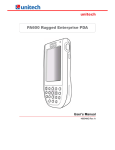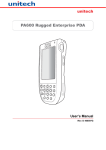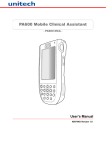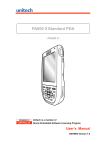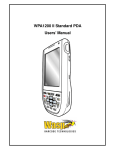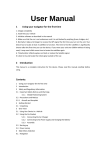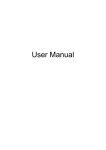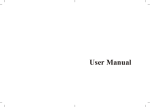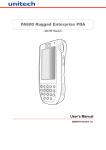Download Unitech Windows Mobile PA600 II User`s manual
Transcript
unitech PA600 II Rugged Mobile Computer - Windows MobileTM Phone Edition - User’s Manual 400646G Version 1.0 Preface About This Manual This manual explains how to install, operate and maintain the PA600 II Rugged Mobile Computer. No part of this publication may be reproduced or used in any form, or by any electrical or mechanical means, without permission in writing from the manufacturer. This includes electronic or mechanical means, such as photocopying, recording, or information storage and retrieval systems. The material in this manual is subject to change without notice. © Copyright 2008 unitech Electronics Co., Ltd. All rights reserved. unitech global website address: http:\\www.unitech-adc.com Bluetooth is a registered trademark of Bluetooth SIG. Microsoft, Windows and ActiveSync are either registered trademarks or trademarks of Microsoft Corporation. Other product names mentioned in this manual may be trademarks or registered trademarks of their respective companies and are hereby acknowledged. unitech is a member of Oracle Embedded Software Licensing Program. Regulatory Compliance Statements FCC Warning Statement This equipment has been tested and found to comply with the limits for a Class B digital device, pursuant to part 15 of the FCC rules. These limits are designed to provide reasonable protection against harmful interference in a residential installation. This equipment generates, uses and can radiate radio frequency energy and, if not installed and used in accordance with the instructions, may cause harmful interference to radio communications. However, there is no guarantee that interference will not occur in a particular installation. If this equipment does cause harmful interference to radio or television reception, which can be determined by turning the equipment off and on, the user is encouraged to try to correct the interference by one or more of the following measures: • • Reorient or relocate the receiving antenna. Increase the separation between the equipment and receiver. i • • Connect the equipment into an outlet on a circuit different from that to which the receiver is connected. Consult the dealer or an experienced radio/TV technician for help. 1. This Transmitter must not be co-located or operating in conjunction with any other antenna or transmitter. 2. This equipment complies with FCC RF radiation exposure limits set forth for an uncontrolled environment. To maintain compliance with FCC RF exposure compliance requirements, avoid direct contact to the transmitting antenna during transmitting. 3. Any changes or modifications (including the antennas) made to this device that are not expressly approved by the manufacturer may void the user’s authority to operate the equipment. FCC Label Statement This device complies with part 15 of the FCC rules. Operation is subject to the following two conditions: 1. This device may not cause harmful interference, and 2. This device must accept any interference received, including interference that may cause undesired operation. Canadian Compliance Statement This Class B Digital apparatus meets all requirements of the Canadian InterferenceCausing Equipment Regulations. Cet appareil numerique de la classe B respecte les exigences du Reglement sur le material broilleur du Canada. European Conformity Statement Declaration of Conformity with Regard to the R&TTE 1999/5/EC and EMC 89/336/ EEC directives. ii About This Manual Laser Information The unitech PA600 II series is certified in the U.S. to conform to the requirements of DHHS/CDRH 21CFR Subchapter J and to the requirements of IEC 825-1. Class II and Class 2 products are not considered to be hazardous. The PA600 II series contains internally a Visible Laser Diode (VLD) whose emissions do not exceed the maximum limits as set forth in the above regulations. The scanner is designed so that there is no human access to harmful laser light during normal operation, user maintenance or during prescribed service operations. The laser safety warning label required by the DHHS/IEC for the PA600 II series's optional laser scanner module is located on the memory compartment cover, on the back of the unit. CAUTION! Use of controls or adjustments or performance of procedures other than those specified herein may result in hazardous laser light. Use of optical instruments with the scanner will increase eye hazard. Optical instruments include binoculars, microscopes, and magnifying glasses. This does not include eye glasses worn by the user. Battery Notices This unit is equipped with a battery pack and backup battery. Both batteries will discharge after an extended period of not being used. When both batteries are discharged, recharge the unit for 16 hours in order to fully charge the main battery and backup battery. There are two ways to recharge PA600 II: 1. Plug the USB charging cable to the PA600 II and plug the 5V/3A AC-DC adapter to the power jack of the USB charging cable. 2. Place the PA600 II into the docking station and plug the 5V/3A AC-DC adapter to the power jack of the docking station. For more details, refer to page 8, Charging the Battery. If the main battery is removed, the backup battery ensures the data on SDRAM is safe for up to 2 hours. To prevent data loss, do not leave the PA600 II uncharged with the main battery removed for an extended period. Battery charge notice It is important to consider the environment temperature whenever you are charging the Lithium-Ion battery pack. The process is most efficient at normal room temperature or slightly cooler. It is essential that you charge batteries within the stated range of 10°C to 45°C. Charging batteries outside of the specified range could damage the batteries and shorten their charging life cycle. iii Storage and safety notice Although charged Lithium-Ion batteries may be left unused for several months, their capacity may be depleted due to build up of internal resistance. If this happens they will require recharging prior to use. Lithium-Ion batteries may be stored at temperatures between -20°C to 60°C, however they may be depleted more rapidly at the high end of this range. It is recommended to store batteries within normal room temperature. iv Table of Contents Preface About This Manual i Regulatory Compliance Statements ............................................................................. i FCC Warning Statement.......................................................................................................... FCC Label Statement .............................................................................................................. Canadian Compliance Statement ............................................................................................ European Conformity Statement ............................................................................................. i ii ii ii Laser Information ................................................................................................................ iii Battery Notices ..................................................................................................................... iii Battery charge notice.............................................................................................................. iii Storage and safety notice ....................................................................................................... iv Chapter 1 Getting Started 1 Introducing the PA600 II ................................................................................................... Features ................................................................................................................................... Package Contents ............................................................................................................... A Tour of the PA600 II ........................................................................................................ 1 2 3 3 Front Left View........................................................................................................................ 4 Back View ............................................................................................................................... 5 Getting Started...................................................................................................................... 6 Installing the Battery ............................................................................................................... 6 Charging the Battery............................................................................................................... 8 Charging the Battery using the USB Cable ....................................................................... 8 Charging the Battery with the Docking Station .................................................................. 9 Checking the Battery Status .............................................................................................. 9 Connecting the PA600 II to a PC.......................................................................................... 10 Turning the PA600 II on for the First Time............................................................................ 11 Powering On.................................................................................................................... 11 Calibrating the PA600 II Screen ...................................................................................... 12 Chapter 2 Using the Hardware Keypads and Function Buttons ................................................................................... Adjusting the Screen Brightness ................................................................................ Using the Stylus ................................................................................................................. Using the SD/MMC memory card ................................................................................ 14 14 16 16 17 Inserting a Storage Card ................................................................................................. 17 Removing a Storage Card ............................................................................................... 17 Using the Laser Scanner ................................................................................................ 18 Using the SIM Card ........................................................................................................... 19 Inserting the SIM Card..................................................................................................... 19 v Using the Phone ................................................................................................................. 20 Making a Call Using the Phone Keypad ............................................................................... Using the Contact List........................................................................................................... Using the Speed Dial ............................................................................................................ Customizing the Phone Settings........................................................................................... Chapter 3 Getting Connected 21 21 22 22 23 Establishing Device-PC Connection.......................................................................... 23 Installing Microsoft ActiveSync ............................................................................................. 23 Connecting the Device to Your Computer ............................................................................ 26 Synchronizing with Your Computer........................................................................... 27 Connection options ............................................................................................................... USB Connection .............................................................................................................. Bluetooth Connection ...................................................................................................... GPRS Connection ........................................................................................................... WiFi Connection .............................................................................................................. 27 27 27 30 31 Synchronizing Information ............................................................................................ 35 Synchronization Options....................................................................................................... 35 Using ActiveSync to Exchange Files ........................................................................ 35 Chapter 4 Barcode Scanner Programs 37 Scanner Setting .................................................................................................................. 37 Scan2Key .............................................................................................................................. 37 Barcode Symbologies........................................................................................................... 38 Chapter 5 Advanced Settings 39 Adjusting Settings ............................................................................................................. 39 Checking the Main and Backup Battery Status..................................................... 40 Extending Battery Life ..................................................................................................... 41 Changing the Automatic Power Settings .............................................................................. 41 Adjusting Backlight Setting ................................................................................................... 42 Viewing Flash Memory Files ......................................................................................... 43 Performing a hardware reset ........................................................................................ 44 Performing a Warm Boot ...................................................................................................... 44 Performing a Cold Boot ........................................................................................................ 45 Performing a Clean Boot ...................................................................................................... 46 Appendix System Specifications vi 47 Chapter 1 Getting Star ted Introducing the PA600 II Thank you for purchasing the PA600 II Rugged Mobile Computer. Your PA600 II was designed for users who need a compact and durable PDA for data collection and real time transactions. The PA600 II is a rugged, compact and lightweight palm-size computer using the Windows Mobile 5.0 operating system, and incorporating an integral bar code scanning laser device, cell phone function, color LCD with touchscreen, keypad, and wireless communication capability. It provides users with a standard Windowsbased environment for customizing and operating the device. To reduce TCO, the PA600 II is sealed to meet IP64 standards and has undergone multiple drop tests to prevent downtime. 1 Chapter 1 Getting Started Features Powerful system • • Microsoft Windows MobileTM 5.0 operating system Intel PXA270 processor with speed of up to 624 MHz System memory • 128 MB SDRAM • 320 MB Flash ROM Wireless connectivity • 802.11b/g with diversity antenna • Bluetooth wireless technology Display • 3.5-inch QVGA TFT-LCD with touch screen and backlight • 240 x 320 resolution Expansion slot • Secure Digital (SD) card slot (supports SDHC up to 4G) Barcode scanner • Built-in laser scan engine • Built-in vibrator for scanning indication • Symbol SE950 support • Unitech Hamster barcode decoder Communication • USB Host & Client • Bluetooth 2.0 + EDR (supports Bluetooth Printer, Bluetooth Modem, Bluetooth ActiveSync) • eGPRS Siemens MC75 Radio Module, quad-band GSM 850/900/ 1800/1900 MHz – EDGE Multislot Class 10 – GPRS Multislot Class 12 – GSM Release 99 2 Audio • MIC • Speaker • Headset Connector • Receiver Battery life • Operation time: typical 5 hours (with Wifi), average 9 hours (w/o Wifi) • Charging time: under 5 hours • Embedded backup battery cell User-friendly interface • Quick launch hot keys for enabling backlight, calibration, phone calls, software keyboard, and other device management tasks • Trigger keys for barcode scanning Copyright 2008 unitech Electronics Co., Ltd. All rights reserved. unitech is a registered trademark of unitech Electronics Co., Ltd. Chapter 1 Getting Started Package Contents After opening the box, ensure the following accessories for the PA600 II are present: PA600 II Terminal AC Adapter with universal plugs Battery Pack USB Charging Cables Stylus CD-ROM Quick Reference Guide If anything is missing or appear damaged in any way, contact your dealer. A Tour of the PA600 II The following sections describe the main components and features of the PA600 II. 3 Chapter 1 Getting Started Front Left View 1 8 7 6 2 5 3 4 No. Component Description 1. Status indicator Indicates the battery charging and barcode scanning status. Green - Battery is fully charged, or barcode scanning process is completed without error. Red - Battery is charging, barcode scanner is fired/ activated. 2. Left scanner trigger button Power button Press to activate the barcode laser scanner. 3. 4 4. 5. Microphone Universal connector 6. Keypad 7. LCD touch screen 8. Speaker If the device is off, press this button to turn it on. Alternatively, when the unit is on, this key must be pressed and held down for about three seconds in order to turn the device off. Enables you to record voice audio. Connects your device to a USB charging/ communication cable. This USB cable connects to the computer’s USB port and accepts the 5V AC adapter to provide power to the PA600 II. See page 16 for further instructions. This unit can simultaneously recharge and perform an ActiveSync operation. You can also use it to connect peripheral hardware, such as a docking station, to your device. This port can also support USB and RS232 hosting for devices such as a USB or RS232 scanner, keyboard, or USB memory key. Keypad interface for controlling the PA600 II. See Keypads and Function Buttons on page 14 for more information. Displays the applications and data stored on your device. It is touch-sensitive and responds to the stylus or finger. Enables you to hear audio from the PA600 II. Copyright 2008 unitech Electronics Co., Ltd. All rights reserved. unitech is a registered trademark of unitech Electronics Co., Ltd. Chapter 1 Getting Started Back View 9 10 11 12 13 14 15 16 17 No. 9. Component Battery compartment 10. Battery compartment release latch 11. Reset button 12. Handstrap 13. 14. Speaker Stylus 15. Strap holder 16. Memory card slot 17. Barcode scanner window Description Houses the removable and rechargeable 3.7 V, 2200 mAH battery pack Opens the battery compartment. Press the end of the stylus into the button to reset your device. Enables you to securely hold the PA600 II while using it. Enables you to hear audio from the PA600 II. Enables you to interact with the operating system. To use the stylus, remove it from its holder and hold it the same way as you hold a pen or pencil. Attachment location for holding hand strap, carrying strap, and stylus. Accommodates Secure Digital (SD) memory cards and can serve as an SDIO port. Scan barcodes window where the laser pass through. 5 Chapter 1 Getting Started Getting Started This section explains how to install and charge the battery, how to check battery status, how to turn on the PA600 II, and how to calibrate the screen. Installing the Battery WARNING! There is a risk of fire and burns if the battery pack is handled improperly. DO NOT disassemble, crush, puncture, short external contacts, or dispose the battery pack in fire or water. DO NOT attempt to open or service the battery pack. Dispose of used batteries according to local recycling guidelines in your area. A backup battery cell is embedded into your device to prevent data loss in instances when the removable battery pack is removed or completely discharged. This backup battery cell will keep the data and system setting for up to 6 hours if the main battery is removed. NOTE: To enable the internal battery cell to provide backup power supply, charge your device with the main battery pack for at least 16 hours. 1. Open the battery compartment by pushing the latch in the direction of the arrow and lifting up. The battery compartment is displayed: Compartment contacts Plastic battery tab Battery hook NOTE: 6 The plastic battery tab makes it easy to remove the battery. Copyright 2008 unitech Electronics Co., Ltd. All rights reserved. unitech is a registered trademark of unitech Electronics Co., Ltd. Chapter 1 Getting Started 2. Locate the backup battery switch and turn it on. Backup battery switch 3. Position the battery pack, making sure the battery contacts are aligned with the contacts in the compartment and the battery is placed on top of the plastic tab, as shown in the following illustration. Contacts Plastic tab 4. Slide the battery pack into the battery bay while simultaneously pulling the battery hook until the battery clicks into place. Battery hook 5. Replace the battery compartment cover. 7 Chapter 1 Getting Started Charging the Battery Before using the PA600 II for the first time, you need to charge it for about 16 hours. After that, you can charge the PA600 II 4 hours to recharge the battery to full capacity. Charge the PA600 II using the USB charging cable or the docking station. CAUTION! Operating the PA600 II for the first time without the AC adapter, and without fully charging the backup battery may result in loss of data stored in RAM memory. When the main battery is removed, the backup battery retains RAM data in memory for 2 hours, please charge the battery for the period to avoid the data loss in RAM memory. NOTE: Turn the backup battery switch on before charging the battery. Data you entered may not be properly stored until the built-in backup battery has been adequately charged. Charging the Battery using the USB Cable 1. Press and hold the connector button on the USB charging cable and connect it to the PA600 II (1). 2. Plug the AC adapter cable into the power jack on the USB charging cable (2). 3. Connect the AC adapter into an electrical outlet (3). 2 3 1 8 Copyright 2008 unitech Electronics Co., Ltd. All rights reserved. unitech is a registered trademark of unitech Electronics Co., Ltd. Chapter 1 Getting Started Charging the Battery with the Docking Station 1. Plug the AC adapter cable into the power jack on the docking station, then connect the AC adapter into an electrical outlet. 2. Slide the device into the docking station until it clicks into place. 3. The connection is secure when the bottom edge of the device is aligned with the docking station, and the LED indicator on the device lights up red. LED Status PA600 II Docking Station LED Solid Red Solid Green Power LED Meaning Charging Charging complete Power is on Charging LED: Charging (For spare battery only) Sync LED Synchronization is taking place Checking the Battery Status If the battery level becomes low in the course of normal use, a status icon appears on the device screen indicating low or very low battery status. In both cases, perform an ActiveSync operation to back up your data, then recharge your device as soon as possible. If the battery level reaches low status, the device will enter a sleep mode and cannot be powered up until the battery is charged. Windows Mobile 5.0 devices will retain installed applications and data when the main battery is completely drained for extended periods of time. 9 Chapter 1 Getting Started Connecting the PA600 II to a PC Use the USB cable to connect the PA600 II to a PC, in order to use with ActiveSync. 1. Press and hold the connector button on the USB charging cable and connect it to the PA600 II (1). 2. Plug the USB connector into the USB port on the PC and connect the AC adapter into the USB connector (2). 3. Connect the AC adapter into an electrical outlet (3). 2 3 1 10 Copyright 2008 unitech Electronics Co., Ltd. All rights reserved. unitech is a registered trademark of unitech Electronics Co., Ltd. Chapter 1 Getting Started Turning the PA600 II on for the First Time After you have initially charged your device for about 16 hours, the device is ready to be used. You can now start up your device where you’ll calibrate the display, learn some basic stylus usage, and set up the system time zone, date and time. Powering On 1. Turn on your device by pressing the power button on the front panel. NOTE: The PA600 II screen ships with a protective plastic film. You may remove this if desired by peeling from one corner. The screen will be more susceptible to scratching without the film, but will be more readable. 2. The unitech PA600 II welcome screen appears for a moment followed by the Windows Mobile screen. Power Button FUNC ALPHA abc Rs Ls 1 ESC 2 ghi 4 5 pqrs 7 def 3 jkl TAB mno 6 tuv OK ENTER wxyz 8 9 0 . key 11 Chapter 1 Getting Started Calibrating the PA600 II Screen The calibrate screen automatically appears when the unit is powered-on for the first time or after the system is reset. To calibrate the screen at any time, follow these instructions. 1. Tap Start → Settings, and then switch to System tab. 2. Tap the Screen icon. Or Press Func key and ESC key simultaneously. The Screen Settings window appears. This Window enables you to customize the screen settings. 3. Tap Align Screen to calibrate the screen. The align screen window appears. 4. Tap the cross hair firmly and accurately. 12 Copyright 2008 unitech Electronics Co., Ltd. All rights reserved. unitech is a registered trademark of unitech Electronics Co., Ltd. Chapter 1 Getting Started The cross hair moves to the next location. 5. Continue tapping the cross hairs until the screen has been calibrated. 13 Chapter 2 Using the Hardware Keypads and Function Buttons The keypad enables you to both enter information and interact with the PDA operating system and also operate secondary functions using the function button. When the green function button is pressed, the green icon functions on the keypad become available. Function activated icon When the Function button is pressed, an icon appears in the operating system: The following table describes the keypad keys. Key 14 Main Function Secondary Function Talk/Send Opens Phone screen to make a call or send a message — Enables/ disables secondary function keys Alpha — End Exits Phone screen or ends a call Turns the PA600 II on and off. — Copyright 2008 unitech Electronics Co., Ltd. All rights reserved. unitech is a registered trademark of unitech Electronics Co., Ltd. Chapter 2 Using the Hardware Key Main Function Secondary Function Number 1 Left soft key - activates function above in LCD screen. Alphanumeric 2, a, b, c Up navigation key Alphanumeric 3, d, e, f Right soft key - activates function above in LCD screen. Tab Windows key opens Start menu Back space Escape key Alphanumeric 4, g, h, i Left navigation key Alphanumeric 5, j, k, l — Alphanumeric 6, m, n, o Right navigation key Alphanumeric 7, p, q, r, s Decreases screen brightness Alphanumeric 8, t, u, v Down navigation key Alphanumeric 9, w, x, y, z Increases screen brightness Asterisk Illuminates keypad Number 0, space — Period Pound Enter key OK 15 Chapter 2 Using the Hardware Adjusting the Screen Brightness Adjust the screen brightness by pressing the Function button to enable the soft keys and pressing the 7 (decrease brightness) or 9 (increase brightness) buttons. Function Button FUNC ALPHA abc Rs Ls 1 ESC Decrease Brightness 2 ghi 4 jkl 5 pqrs 7 def 3 TAB mno 6 tuv OK ENTER wxyz 8 9 0 . key Increase Brightness Using the Stylus CAUTION! Never use anything other than the PA600 II stylus on the screen. Otherwise this could cause a permanent damage. 1. Remove the stylus from its holder. 2. Hold the stylus as you hold a pencil. 3. To make a choice from a menu, lightly tap the tip of the stylus on that choice. 4. To write data into a field on a form, use the stylus to print the letters or numbers. Use very light pressure. 16 Copyright 2008 unitech Electronics Co., Ltd. All rights reserved. unitech is a registered trademark of unitech Electronics Co., Ltd. Chapter 2 Using the Hardware Using the SD/MMC memory card Your device has an expansion slot compatible with a range of SD and MMC storage cards, which are primarily used to back up or transfer files and data. The slot also supports SDIO cards for added connectivity options. Inserting a Storage Card 1. Remove the four screws from the SD compartment cover and remove the cover. 2. Insert the SD card with the notched corner as shown by the icon on the case. 3. Replace the SD compartment cover and the four compartment screws. Removing a Storage Card 1. Remove the four screws from the SD compartment cover and remove the cover. 2. Press the card in and release. The card pops out. 3. Remove the card from the slot. 17 Chapter 2 Using the Hardware Using the Laser Scanner The PA600 II has an integrated laser scanner which reads all major bar code labels with excellent performance. NOTE: Scanning software must be enabled in order to operate the scanner. This can be a user-loaded application or a pre-loaded utility such as Scanner Setting and Scan2Key. Activate the laser scanner by pressing either one of the trigger keys located on the left and right side of the unit. Scan button The PA600 II has a built-in Scanner Setting utility that allows you to test the device’s barcode scan function. 1. To launch Scanner Settings, tap Start → Settings, and then switch to System tab. Tab the Scanner icon. 2. The Scanner Control Panel opens. From here you can configure barcode scanner parameters such as enabling or disabling barcode symbologies, setting data transmission options, configuring magnetic and proximity reading options, and setting power management options. 18 Copyright 2008 unitech Electronics Co., Ltd. All rights reserved. unitech is a registered trademark of unitech Electronics Co., Ltd. Chapter 2 Using the Hardware 3. To test the barcode scanner, tap the Test tab. 4. Tap Tools 5. Tap Enable Scan 6. To perform auto scan, Tap Tools → Auto Scan → Start Auto- Scan 7. Choose Interval: 3 secs 8. Tap: Start 9. Laser scans every 3 seconds and barcode is scanned automatically. 10. Tap Tools → Auto-Scan → Stop AutoScan. Using the SIM Card The PA600 II has a slot for GPRS SIM card. It is placed inside the battery compartment. Inserting the SIM Card 1. Take out the battery cover and the main battery. Insert the SIM card with the notched corner as shown in the picture below. NOTE: The chip of the SIM card should face upwards. 2. Push the SIM card to the end until you hear a click. Push the lock to the right to lock the card by stylus. 19 Chapter 2 Using the Hardware Using the Phone The PA600 II has an integrated phone keypad, which allows you to make, receive, and send messages via the built-in module. NOTE: Make sure you insert the SIM card properly. To open the Phone screen, do one of the following. 1. Tap Phone on the bottom left corner of the screen. 2. Press Talk/Send button. Press End button when you want to exit the Phone screen. Talk/Send button End button FUNC ALPHA abc Rs Ls 1 ESC 2 ghi 4 5 pqrs 7 def 3 jkl TAB mno 6 tuv OK ENTER wxyz 8 9 0 . key The Phone screen opens. From here you can manage the contact list, create speed dials, messages, notes, and customize phone settings. NOTE: If you SIM card is protected by a PIN code, input the password before you can use the phone. Tap the antenna signal icon on the upper right corner of the screen. Tap Wireless Manager and turn on phone function. Antenna signal icon Signal Description Phone service searching No signal is available. Strongest signal strength More bars you have, the stronger signal you have. No phone service provided. Phone keypad 20 Phone function is turned off. Tap the antenna signal icon and turn on phone function in the Wireless Manager. Copyright 2008 unitech Electronics Co., Ltd. All rights reserved. unitech is a registered trademark of unitech Electronics Co., Ltd. Chapter 2 Using the Hardware Speaker icon Tap the speaker icon on the upper right corner of the screen. You can adjust the device/ phone volume by moving the sliders and change the ring volume by tapping On, Vibrate, or Off. Making a Call Using the Phone Keypad 1. 2. 3. 4. Tap Phone or press Talk/Send button. Enter the desired phone numbers. Tap the Talk button on the Phone screen. When the call connects, you can tap Hold to place the first number on hold. 5. Enter the second phone numbers and tap Talk again. 6. Tap Swap to switch between calls. 7. Tap End or press End button to stop dialing or end the call. Using the Contact List 1. Tap Contacts on the bottom left corner of the Phone screen. 2. Tap New on the bottom left corner of the contact list, you can add a new contact. 3. Tap a contact, you can edit the contact info. 4. Tap and hold on a contact, a menu appears. You can send e-mail/ text message to the contact, add this contact to speed dial list, and so on. 21 Chapter 2 Using the Hardware Using the Speed Dial 1. Tap Speed Dial on the Phone keypad. 2. Tap Menu, and select New. 3. Select a contact in your contact list by tapping the desired contact. 4. Assign an available location for the new speed dial entry. Tap OK, and then OK to exit the speed dial list. NOTE: The first speed dial location is reserved for voice mail. To make speed dial call, do one of the following. 1. Tap and hold the speed dial location number assigned to a contact on the Phone keypad. 2. Tap Speed Dial on the Phone keypad, and tap the location number of the desired speed dial entry. Location number Customizing the Phone Settings Tap Menu, and select Options, you can change the default phone settings, including ring sound, keypad sound, call barring, call forwarding, call waiting, mobile phone network, etc. 22 Copyright 2008 unitech Electronics Co., Ltd. All rights reserved. unitech is a registered trademark of unitech Electronics Co., Ltd. Chapter 3 Getting Connected Establishing Device-PC Connection Installing Microsoft ActiveSync In order to exchange data between your computer and PA600 II, Microsoft ActiveSync must be installed on your computer. Use the USB charging cable that comes with your device to connect the device to your computer. NOTE: If you have a previous version of the Microsoft ActiveSync installed in your computer, uninstall it first before installing the latest version of Microsoft ActiveSync. To install Microsoft ActiveSync on your computer: 1. Close any open programs, including those that run at startup, and disable any virus-scanning software. 2. Download the ActiveSync software from the Microsoft ActiveSync Download page at http://www.microsoft.com/windowsmobile/downloads/activesync42.mspx. 3. Browse the location of the downloaded file, and double-click it. The installation wizard begins. 23 Chapter 3 Getting Connected 4. Click Next. You are prompted to read the End User License Agreement (EULA). 5. Accept the license agreement terms and click Next. You are prompted for user information. 6. Type the user name and organization and click Next. You are prompted for the destination folder. 24 Copyright 2008 unitech Electronics Co., Ltd. All rights reserved. unitech is a registered trademark of unitech Electronics Co., Ltd. Chapter 3 Getting Connected 7. Select a drive to install the program and click Next. The installation wizard has gathered the information it needs to install ActiveSync and prompts you to begin the installation. 8. Click Install. The program begin the installation After the program has finished installing you see the following screen. 25 Chapter 3 Getting Connected 9. Click Finish. You may be prompted to restart your computer. After you have installed ActiveSync and restarted your computer, the ActiveSync icon appears in your computer’s system tray as shown and ActiveSync Connection Wizard starts. For detailed information on how to use ActiveSync on your computer, start ActiveSync then click Help → Microsoft ActiveSync Help. Connecting the Device to Your Computer 1. After ActiveSync has been installed, connect the USB charging cable to the universal connector on the bottom of your device. If necessary, connect an adapter. Refer to Connecting the PA600 II to a PC on page 10. 2. Plug the other end of the USB charging cable into a USB port on your computer. 3. Turn the device on. 4. ActiveSync starts automatically and configure the USB port to work with the PA600 II. The New Partnership setup wizard will automatically start. NOTE: If ActiveSync doesn’t start automatically, click Start → Programs → Microsoft ActiveSync. If a message appears indicating that it is unable to detect a connection, click the Cancel button and manually configure the communication settings. 5. Follow the onscreen instructions. 6. When the configuration process is complete, the ActiveSync window appears. 7. Synchronization will be initialized and will take place if you’ve chosen to synchronize periodically or upon connection. NOTE: 26 Your computer can create a partnership with multiple PA600 IIs. Also, a PA600 II can create a partnership with up to two computers. Copyright 2008 unitech Electronics Co., Ltd. All rights reserved. unitech is a registered trademark of unitech Electronics Co., Ltd. Chapter 3 Getting Connected Synchronizing with Your Computer Synchronization takes place according to the options you choose while setting up ActiveSync on your computer. If you accept the default (On Connect) synchronization option in the Microsoft ActiveSync Setup Wizard, you’ll be able to simply connect your PA600 II to your desktop computer and synchronization will take place. If you have not enabled the On Connect feature in Active Sync, you can start ActiveSync in either of the following ways: • • On your computer, double-click My Computer → Mobile Devices folder. Connect the USB cable between the computer and PA600 II. Connection options You can set remote synchronization with your computer using the following connection options: • • • • USB connection Bluetooth connection GPRS Connection WiFi connection USB Connection To synchronize with your computer using a USB connection: 1. Connect your device to your computer using the USB charging cable. 2. Initiate connection by tapping Start → Programs → ActiveSync. 3. Tap Menu → Connections. 4. Select Synchronize all PCs using this connection check box. 5. Select a baud rate or cable type connection. 6. Tap OK. Bluetooth Connection Your device is equipped with Bluetooth wireless technology that you can use to synchronize information with a computer equipped with a Bluetooth adapter or access point. Bluetooth wireless technology allows you to communicate with the computer whenever it is within range. Follow these instructions to set up a Bluetooth connection. 27 Chapter 3 Getting Connected 1. Tap Start → Settings → Connections → Bluetooth → Mode and check Turn on Bluetooth. 2. Tap Devices → Add new device. 3. Select a device from the list and tap Next. 28 Copyright 2008 unitech Electronics Co., Ltd. All rights reserved. unitech is a registered trademark of unitech Electronics Co., Ltd. Chapter 3 Getting Connected 4. .You are prompted for a passkey. 5. Enter the Passkey. On the PC screen, you are prompted to enter the Bluetooth PIN Code Request. 6. Enter the same Bluetooth PIN Code you entered in step 4. 7. Select service. Check Activesync and tap Finish. 8. To preserve battery power, be sure to end the bluetooth activesync connection when synchronizing is complete. Tap OK. 9. From Start → Programs, double tap ActiveSync. 10. Tap Menu at right bottom corner. Select Connect via Bluetooth. Terminal connects to the host via Bluetooth Activesync. 29 Chapter 3 Getting Connected GPRS Connection PA600 II comes with a built-in GPRS module, which allows you to connect to the internet. Follow the instructions below to access the internet. NOTE: Make sure you insert the SIM card properly. See Using the SIM Card on page 19. 1. Tap Start → Settings. Under Connections tab, tap Connections. 2. Under My ISP, tap Manage existing connections. 30 Copyright 2008 unitech Electronics Co., Ltd. All rights reserved. unitech is a registered trademark of unitech Electronics Co., Ltd. Chapter 3 Getting Connected 3. Tap and hold the GPRS (internet) in the list. Select Connect. A prompt appears, you are connected to internet via GPRS. WiFi Connection With the device’s embedded WLAN module, you can send and receive signals to a WiFi network then synchronize files. NOTE: WiFi access requires a separate purchase of a service contract with a wireless service provider. Contact a wireless service provider for more information. A wireless network can be added either when the network is detected or by manually entering settings information. Before doing these steps, determine if authentication information is needed. 1. If the WIFI icon appears on the device, double-tap the icon and tap enable wireless. WiFi icon 31 Chapter 3 Getting Connected 2. Tap the Wireless Manager icon. 3. Tap Menu at the right bottom corner of Wireless Manager. Select Wireless Settings. 4. If there are available networks detected, tap and hold the network name, and then select Connect. 32 Copyright 2008 unitech Electronics Co., Ltd. All rights reserved. unitech is a registered trademark of unitech Electronics Co., Ltd. Chapter 3 Getting Connected NOTE: Press Func key and “9” button to bring the Device Setting screen. Under IO, select Wireless and Enable. While Multiple Networks Detected screen pop up, select a network to connect. Follow instructions below to add a new wireless network. 1. Tap Add New. Configure Wireless Network screen appears. 2. Enter a name for the network. Tap Next. 33 Chapter 3 Getting Connected 3. Enter the network key. Tap Next. 4. Tap Finish. Configure Wireless Network screen appears again, and the new wireless network becomes available in the list. To disable the wireless network, you may do one of the following. 1. Double-tap the WIFI icon and tap Disable Wireless. 2. Tap the Wi-Fi bar in the Wireless Manager screen. 3. Press Func key and “9” button to bring the Device Setting screen. Under IO, select Wireless and Disable. 34 Copyright 2008 unitech Electronics Co., Ltd. All rights reserved. unitech is a registered trademark of unitech Electronics Co., Ltd. Chapter 3 Getting Connected Synchronizing Information All files created on the device are stored in My Document/PA600 II My Document folder (if the designated device name is PA600 II). You can view files by double-clicking the PA600 II My Documents icon on your computer. If you have enabled file synchronization, your PA600 II files are automatically synchronized in the My Documents folder on your computer, unless a different name was chosen for PA600 II. Synchronization Options Synchronization options can be modified, including when you synchronize and what gets synchronized. In the Mobile Device window, click Tools → Sync Options. For each type of information, the synchronization process can be hastened by limiting the amount of data to be synchronized. To do this, select a service and click the Settings button. After enabling a service, you must close and reopen the ActiveSync. Using ActiveSync to Exchange Files You can use ActiveSync to exchange information from your device to your computer and vice versa. Changes you made to the information on one location will not affect the information on the other one. If you want to automatically update information on both your device and computer, synchronize the information instead. You can copy two types of information to your device: files and Pocket Access Windows CE Store information. The procedure below only applies to copying files. Refer to the ActiveSync Help on your computer for instructions on how to copy Pocket Access Windows CE Store information. NOTE: Files created on your computer may need to be converted by ActiveSync so that they can be viewed and edited on your device, and vice versa. To copy files: 1. Connect your device to your computer. 2. In ActiveSync on your computer, click Explore. 35 Chapter 3 Getting Connected Windows Explorer opens the Mobile Device window for your device. 3. Locate the file that you want to copy on your device or computer. 4. Do either one of the following: – To copy the file to your device, right-click the file and click Copy. Place the cursor in the desired folder for your device, right-click, then click Paste. – To copy the file to your computer, right-click the file and click Copy. Place the cursor in the desired folder for your computer, right click, then click Paste. 36 Copyright 2008 unitech Electronics Co., Ltd. All rights reserved. unitech is a registered trademark of unitech Electronics Co., Ltd. Chapter 4 Barcode Scanner Programs Scanner Setting When it is necessary for the user to change the default barcode symbology for a different application, the Scanner Control Panel provides the ability to change default symbology, place delimiter characters behind scanned data, and save the settings. Tap Start → Settings → System → Scanner. Scan2Key The Scan2Key application routes input from a scanner port to a keypad buffer, making all input from the scanner emulate input from the keypad. Using Scan2Key, scanned data will be directed from the scanner port to any waiting (active/focused) text editor such as MS Mobile Word or a text box in an applicaton. 37 Chapter 4 Barcode Scanner Programs Barcode Symbologies Check Barcode Enable/ Char/Digit Symbology Disable verification Bookland YES EAN Codabar YES YES YES YES Code 11 YES YES YES Code 128 Code 32 (Pharmacy Code) Code 39 YES YES YES Code 93 Delta Code EAN 128 YES YES YES EAN 13 YES EAN 8 YES Interleaved 2 YES of 5 YES YES YES UPC A UPC E UPC/EAN Group YES YES YES YES YES Transmit code ID, *Fields separator YES YES YES YES YES YES YES *Not suppress start or stop digit, Fixed length, *data length YES YES YES YES *Check digital double module 10, *data length Fixed length, *data length *Standard character set YES YES YES YES YES Transmit start & stop bits, CLSI format, *data length * check digits, *data length *data length Transmit tailing digit Full ASCII, Transmit start & stop bits, Function Code, *data length, Double labels decoding, *Double labels separator *data length YES Label Code YES IV & V MSI/Plessey YES Standard 2 of 5 Telepen Transmit Max/ Transmit Check Min Leading Other Char/digit Length Char/digit YES YES YES YES Zero expansion, NSC Supplement 2, Supplement 5, Insert space before supplement, Must have supplement, *Add-on code try level Note: *Value Adjustable Scanner Control Panel V.5.11 38 Copyright 2008 unitech Electronics Co., Ltd. All rights reserved. unitech is a registered trademark of unitech Electronics Co., Ltd. Chapter 5 Advanced Settings Adjusting Settings This section describes how to adjust the settings of your device to accommodate your work habits. To access Settings, tap Start → Settings. The Settings screen appears. From here you can adjust such user configurable items as the backlight, auto power off timer, system volume, and processor speed. You can also assign functions to buttons, configure menus, enter owner information, and set up connections. 39 Chapter 5 Advanced Settings Checking the Main and Backup Battery Status This section describes how to view the power level for both the main and backup battery. To minimize power consumption, you can define settings for the auto-off function and the processor’s operation speed. To check the main and backup battery status: 1. Open Power Properties. Do either of the following: – If the Plug or Battery icon appears on your device, double-tap the icon to bring the Power Properties screen. Plug icon – Tap Start → Settings → System → Power. NOTE: 40 Press Func key and “8” button. Copyright 2008 unitech Electronics Co., Ltd. All rights reserved. unitech is a registered trademark of unitech Electronics Co., Ltd. Chapter 5 Advanced Settings The Power screen appears. 2. The battery menu item displays the status of the main and backup batteries. On the screen shown here, both batteries are Good. NOTE: It is necessary to charge the battery when the battery charge reaches below 10%. If the battery does not accept a charge, contact unitech Technical Support. Extending Battery Life You can extend the PA600 II battery life by doing either of the following: • • Change the automatic power settings Minimize the use of backlight Changing the Automatic Power Settings The PA600 II will enter idle mode when there is no task, or all tasks are waiting for input. In default setting, the PA600 II automatically turns itself off if it remains idle for 3 minutes and when there is no external charging power connected. Pressing the power button returns the PA600 II to the same point at the time of automatic shutdown. To change the automatic power settings: 1. In the Power screen tap the Advanced tag. 2. Tap the automatic shut off time arrow to select from a list of time periods. The available time periods are 1, 2, 3, 4, and 5 minutes. 3. This function can also be activated when the PA600 II is plugged into the power adapter or placed in its docking station by tapping the On external power check box and then tapping the arrow to select from a list of time periods. The available time periods are 1, 2, 5, 10, 15, and 30 minutes. 41 Chapter 5 Advanced Settings Adjusting Backlight Setting The power consumption of the LCD backlight is high, turn off the backlight function if it is not necessary. If a backlight is required, set “automatically turn off the backlight” function. To change backlight settings: 1. Tap Start → Settings → System. 2. Tap Backlight. 3. The Backlight screen appears. Do any of the following: – In the Battery Power tab, tap the Turn off backlight if device is not used for checkbox and select the amount of time before the unit turns off the backlight while running in battery power mode from the dropdown list. – In the External Power tab, tap the Turn off backlight if device is not used for checkbox and select the amount of time before the unit turns off the backlight while running in external power mode from the dropdown list. – Tap the Turn on backlight when checkbox to activate the backlight when a button is pressed or the screen is tapped. 42 Copyright 2008 unitech Electronics Co., Ltd. All rights reserved. unitech is a registered trademark of unitech Electronics Co., Ltd. Chapter 5 Advanced Settings – In the Brightness tap, tap and drag the slider to adjust a dimmer backlight. Viewing Flash Memory Files The Flash Storage folder is a rewritable location for programs or data files. The benefit of this feature is that files and programs saved in Flash Storage are unaffected by the PA600 II power status. To access the Flash Memory files: 1. Tap My Device > Flash Storage folder. To transfer files to the Device’s flash memory: 1. 2. 3. 4. Connect the device to your computer by ActiveSync. On your computer’s Activesync, Click Mobile Device > Flash Storage. Select the file that you want to transfer. Drag the file from your terminal’s flash storage folder to your computer’s folder or drag the file from your computer’s folder to the terminal’s flash storage folder. 43 Chapter 5 Advanced Settings Performing a hardware reset You may have to perform a reset if the device freezes (i.e., device no longer responds to the buttons or tapping on the screen). A soft reset allows your device to get a fresh start, similar to rebooting a computer. This will restart your device and adjust memory allocation. All records and entries are retained after a soft reset. Unsaved data in open programs may in some cases be lost. Performing a Warm Boot 1. Remove the stylus from its holder. 2. Lightly press the tip of the stylus to the reset button located on the rear of the PA600 II. Reset button 44 Copyright 2008 unitech Electronics Co., Ltd. All rights reserved. unitech is a registered trademark of unitech Electronics Co., Ltd. Chapter 5 Advanced Settings Performing a Cold Boot A cold boot cuts off power of your device, erasing all records and entries, deleting all programs you have added, and restoring the device to default factory settings. When you perform a cold boot, the date and time settings are not be retained. Formats, preferences, and other settings are restored to their default factory settings. Data stored in the flash storage are retained. NOTE: Never perform a hard reset unless a soft reset does not correct your problem. When you perform your next ActiveSync operation, you can restore any data that you previously synchronized to your computer or you can restore data that you backed up to a storage card. Follow these instructions to perform a cold boot. 1. Press the TAB key. FUNC ALPHA abc Rs Ls 1 ESC 2 ghi 4 jkl 5 pqrs 7 def 3 TAB mno 6 OK ENTER wxyz tuv 8 9 0 . key 2. While holding the TAB key, insert the tip of the stylus into the reset hold on the back of the PA600 II. Press and hold the reset button until you see the unitech splash logo screen. Wait 5 seconds and then release the TAB key. NOTE: The system is returned to the default settings. All registry settings and all files (include the hidden files) are returned to their original factory defaults. 45 Chapter 5 Advanced Settings Performing a Clean Boot A clean boot, similar to cold boot, cuts off power of your device, erasing all records and entries, deleting all programs you have added, cleaning storage memory, and restoring the device to default factory settings. When you perform a clean boot, the date and time settings are not be retained. Formats, preferences, and other setting are restored to their default factory settings. Data stored in the flash storage are retained. NOTE: Never perform a hard reset unless a soft reset does not correct your problem. When you perform your next ActiveSync operation, you can restore any data that you previously synchronized to your computer or you can restore data that you backed up to a storage card. Follow these instructions to perform a clean boot. 1. Press and hold the Func key and Backspace key. FUNC ALPHA abc Rs Ls ESC ghi jkl pqrs 7 TAB mno 6 5 4 def 3 2 1 OK ENTER wxyz tuv 8 9 0 . key 2. While holding the Func key and Backspace key, insert the tip of the stylus into the reset hold on the back of the PA600 II. Press and hold the reset button until you see the unitech splash logo screen. Wait 5 seconds and then release the Func key and Backspace keys. NOTE: 46 The system is returned to the default settings. All registry settings and all files (include the hidden files) are returned to their original factory defaults. And this will clean up storage memory. Copyright 2008 unitech Electronics Co., Ltd. All rights reserved. unitech is a registered trademark of unitech Electronics Co., Ltd. Appendix System Specifications Processor / Memory CPU Memory OS Windows MobileTM version 5.0 20-Key, including phone keys, alphanumeric keys, and function keys 240x320 QVGA, Color Transflective TFT, with Touch Screen & backlight Scan rate Keypad Display Laser Barcode Scanner Input Device Indicator Communication Audio Expansion Slot Power Source Enclosure Environmental Certification Accessories Software Scan angle Keypad Touch Screen Full Alphanumeric Software Keyboard Barcode Scanner Led, Vibrator USB Host & Client 802.11b/g Bluetooth 2.0 + EDR Bluetooth supports Bluetooth Printer, Bluetooth Modem, Bluetooth ActiveSync eGPRS (Siemens MC75 Radio Module) MIC Speaker Headset connector Receiver SDIO slot supports SDHC up to 4G Main Backup Weight Dimension Operating temperature Storage temperature Charging temperature Relative Humidity Drop test to Concrete Environmental Sealing CE, CB, FCC, BSMI, CCC, RoHS compliance Battery Cradle Battery Charger Holster 4 slot Multi-Bay Extended Battery Vehicle Dock Microsoft Visual Studio 2005 Microsoft Windows Mobile 5.0 SDK for Pocket PC unitech PA600 SDK Oracle Database Life Wavelink Avalanche MCL development suite Intel PXA270 624MHz SDRAM: 128MB Flash ROM: 320MB 104 scans/sec. ± 12 scans/sec. (bi-directional) 47°±3° default / 35°±3° reduced 3.7V 2200mAh Li-ion battery pack One rechargeable Ni-MH backup battery 290g with battery L149.5 X H26.6 X W85mm -10° C~ 50° C (14° F to 122° F) -20° C~ 60° C (-4° F to 140° F) 10 C~ 45 C 5% ~ 95% (non-condensing) 4 feet (1.2 meter) IP64 47























































